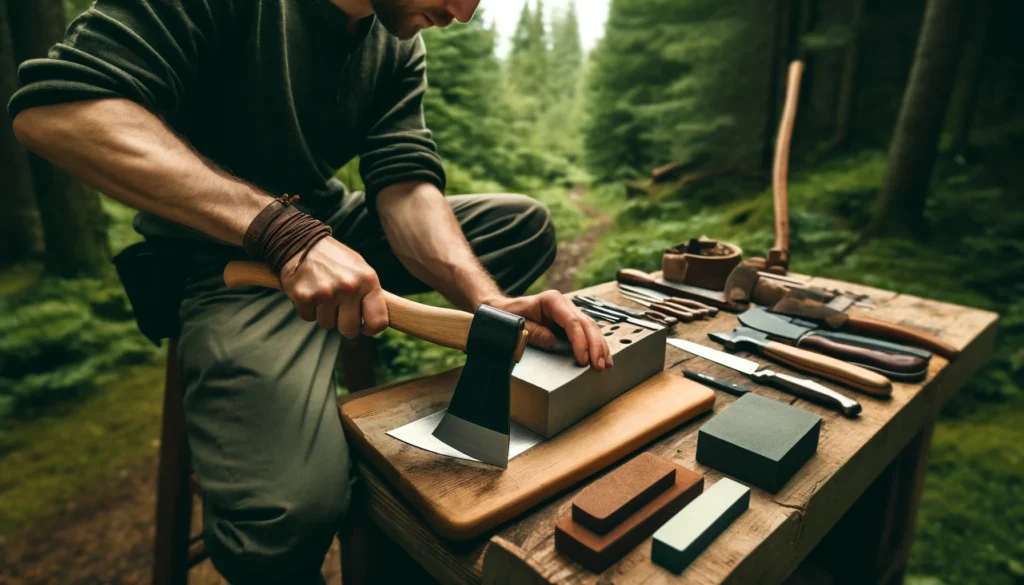How to Sharpen an Axe: A Step-by-Step Guide

Keeping your axe sharp is not just about making chopping wood easier—it’s about safety, efficiency, and preserving the tool’s lifespan. A dull axe requires more force, tires you out faster, and is more likely to slip off the wood, leading to potential accidents. On the other hand, a sharp axe slices cleanly, reduces strain, and ensures smoother, more controlled cuts.
In this comprehensive guide, you’ll learn how to sharpen an axe at home, what tools to use, common mistakes to avoid, and advanced techniques to take your edge to the next level.
Table of Contents
- Why Sharpening an Axe Matters
- 1. Gather Your Tools and Safety Gear
- 2. Preparing the Axe for Sharpening
- 3. Filing the Edge
- 4. Sharpening with a Stone
- 5. Honing the Edge
- 6. Stropping the Edge
- 7. Maintaining Your Axe After Sharpening
- 8. Common Sharpening Mistakes to Avoid
- 9. Advanced Sharpening Techniques
- 10. Sharing Axe Care Knowledge
- Conclusion
- Frequently Asked Questions (FAQs)
Why Sharpening an Axe Matters
- Efficiency: A sharp axe bites into the wood with less effort.
- Safety: Dull blades glance off logs and increase the risk of injury.
- Durability: Regular sharpening preserves the axe head and prevents excessive wear.
- Versatility: A well-sharpened axe can handle tasks ranging from splitting firewood to felling trees with ease.
1. Gather Your Tools and Safety Gear
Before you start sharpening, it’s important to have the right tools and protective equipment on hand.
1.1 Essential Sharpening Tools
- Coarse File: Removes chips and reshapes the edge.
- Sharpening Stone (Dual Grit): A coarse side for shaping and a fine side for honing.
- Honing Oil or Water: Lubricates the stone, reduces heat, and carries away metal filings.
- Strop or Leather Strap: Polishes the edge and removes tiny burrs.
1.2 Safety Gear
- Gloves: Protect your hands from accidental cuts and metal filings.
- Eye Protection: Shields your eyes from sparks, chips, and debris.
- Stable Vice or Clamp: Keeps the axe steady while you work.
2. Preparing the Axe for Sharpening
2.1 Clean the Axe Head
Use steel wool, sandpaper, or a wire brush to remove rust, pitch, and debris. A clean surface ensures your file and stone can make even contact with the blade.
2.2 Secure the Axe
Clamp the axe head in a sturdy vice with the cutting edge facing upward. Stabilizing the axe is critical to maintaining consistent sharpening angles.
3. Filing the Edge
3.1 Choosing the Right File
Select a bastard file (coarse) designed for metalwork. Check that it’s clean, sharp, and free from rust.
3.2 Filing Technique
- Push the file away from you in long, smooth strokes.
- Always maintain the axe’s original bevel angle (typically 25–30°).
- File evenly along the entire edge.
- Work both sides alternately to keep the edge symmetrical.
Pro Tip: Use a marker to color the edge. Filing will remove the ink, showing you where the metal is being ground down.
4. Sharpening with a Stone
4.1 Preparing the Stone
Apply honing oil (for oil stones) or water (for water stones) to reduce friction and prevent clogging.
4.2 Sharpening Process
- Start with the coarse grit.
- Move the stone in small circular or sweeping motions, following the bevel angle.
- Apply light, even pressure.
- Flip the axe and repeat on the other side.
- Continue until the edge feels uniformly sharp.
5. Honing the Edge
5.1 Fine Grit Sharpening
Switch to the fine grit side of the stone. This step smooths out roughness left by the coarse grit and refines the cutting edge.
5.2 Checking for Sharpness
- Visual Check: Hold the blade under a light. A properly sharpened edge will not reflect light.
- Tactile Check: Gently run your thumb perpendicular to the edge (never along it). You should feel a clean, even burr.
6. Stropping the Edge
6.1 Using a Strop
Drag the edge lightly across a leather strop or strap away from the cutting edge. Stropping polishes the blade and removes microscopic burrs.
6.2 Testing Sharpness
Test your axe on a piece of softwood. A sharp axe will bite cleanly into the grain without slipping or bouncing.
7. Maintaining Your Axe After Sharpening
7.1 Regular Maintenance
- Wipe the blade after use.
- Apply a thin coat of oil to prevent rust.
- Store in a dry place, ideally with a protective sheath.
7.2 Safe Handling
Never leave your axe exposed. Use blade covers to prevent accidental cuts and damage.
8. Common Sharpening Mistakes to Avoid
- Over-Sharpening: Removing too much metal weakens the axe head.
- Inconsistent Angles: Leads to uneven cutting and edge failure.
- Skipping Grits: Jumping from coarse directly to fine grit leaves the edge unfinished.
9. Advanced Sharpening Techniques
9.1 Leather Honing Wheel
Mounted on a bench grinder, this can polish your axe to a mirror-like finish for precision work.
9.2 Micro-Beveling
Adding a slight secondary bevel strengthens the edge, making it more durable for splitting and heavy use.
10. Sharing Axe Care Knowledge
- Workshops & Demonstrations: Teach others proper axe sharpening techniques.
- Online Tutorials: Share your skills with a global audience via YouTube or blogs.
Conclusion
Sharpening an axe is a valuable skill that ensures safety, efficiency, and tool longevity. By following the step-by-step process—filing, sharpening with a stone, honing, and stropping—you’ll keep your axe in top condition for any task, whether it’s splitting firewood at camp or felling trees at home.
Frequently Asked Questions (FAQs)
How often should I sharpen my axe?
- Frequency of Sharpening: This depends on usage. Regular users should inspect and sharpen their axes whenever they notice a decrease in cutting efficiency. Typically, sharpening once or twice a season is sufficient for casual users.
Can I use a power grinder to sharpen my axe?
- Caution with Power Tools: While a grinder can speed up the process, it’s easy to remove too much material and overheat the metal, potentially weakening the axe. Manual sharpening is recommended for greater control.
What is the best angle to sharpen an axe?
- Sharpening Angle: Most axes work well with an edge angle of 30 to 40 degrees. However, the ideal angle can vary based on the axe’s use (splitting versus chopping) and the wood type commonly handled.
What type of oil should I use on my axe?
- Choosing the Right Oil: Use natural oils like linseed or mineral oil on the blade. These oils provide protection against rust without harming the metal or the environment.
How can I repair a nicked or damaged axe edge?
- Repair Techniques: Start with a coarse file to work out nicks or significant dullness. Be patient and file evenly along the edge, maintaining the original angle. Finish with finer tools like sharpening stones and strops to restore a sharp edge.
Can sharpening affect the balance of my axe?
- Balance Considerations: Proper sharpening should not affect the balance of your axe significantly. However, removing excessive material from one side more than the other can lead to imbalance. Always strive to remove metal evenly and check the balance periodically if doing extensive sharpening.







